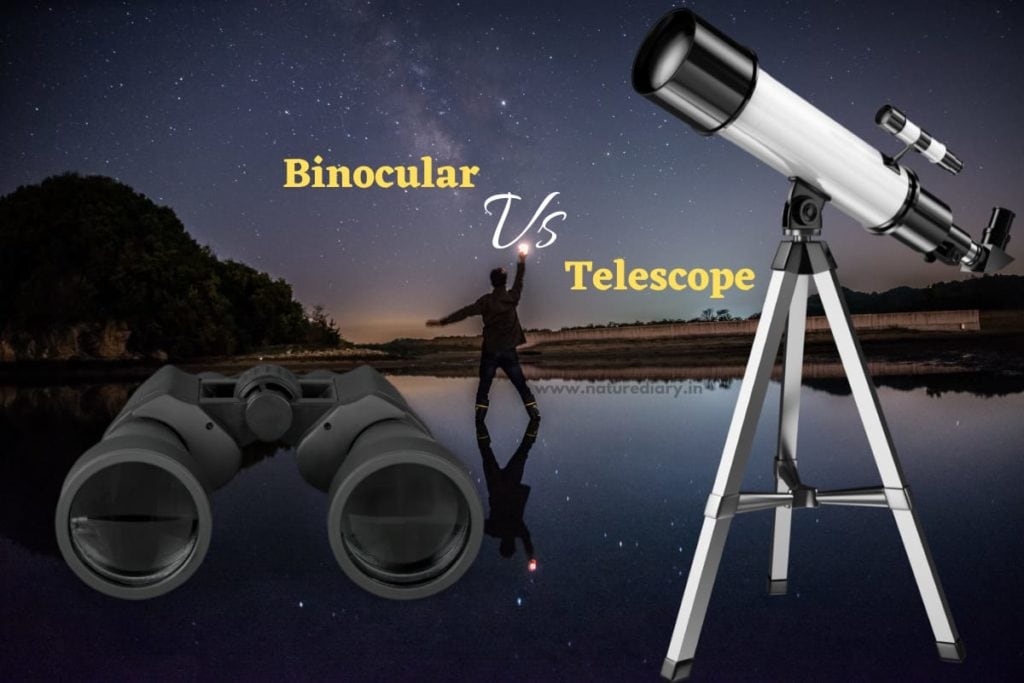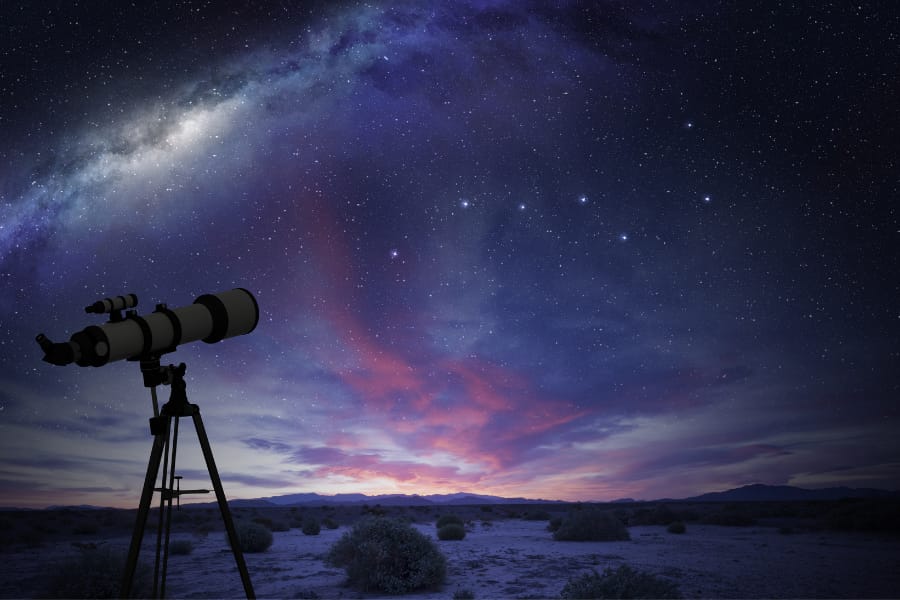Both binoculars and telescopes serve the same purpose of watching distant objects. While you can use a telescope to view stars, planets, and galaxies, a binocular can help you to watch birds, and distant wildlife, and in some cases gaze at the stars.
But, which is better for you?
A comparative study on the differences between binoculars vs. telescopes by comparing their features, pros, and cons will help you find the most suitable device.

Binocular Vs. Telescope
| Point of Difference | Binocular | Telescope |
|---|---|---|
| Lenses | Dual-view (for both eyes) | Singular view (one single eye) |
| Mirror | Doesn’t use a mirror. | Makes use of a mirror for better clarity of vision. |
| Magnification | Zoom ranges from 4x to up to 12x. | Ranges from 12x or 15x, to up to 45x or 60x, and can even be more. |
| Field of view | Wide | Narrow |
| View | Short distances | Long distances |
| Depth of View | Less depth but 3D viewing is possible for dual view. | Flat vision with more depth of view. |
| Weight | Lighter in weight (usually under 2 Kg). | Comparatively heavyweight (usually up to 12 Kg). |
| Portability | Flexible and easy to carry. | Difficult to fold and carry. |
| Price | Lower than telescopes (₹100 to ₹120000). | Higher than microwave (₹1000 to ₹180000) |
Binoculars
In simple words, a Binocular is an optical device to help you see things at a long distance. It is intended for both of your eyes by using two smaller telescopes together for ease of vision for a distance further than you. Since they are suitable for both eyes, it is easier to use and provide comfort of vision and perception.

Types of Binoculars
Check: Best Binoculars for Long Distance
Advantages of binoculars
Limitations of binoculars
Best Uses of Binocular
Binoculars are handy optical devices. You can make use of binoculars while bird watching, star gazing, camping, watching sports, underwater surveillance, above water surveillance, night vision, trekking, hiking, and many more. However, one of the most recent uses of binoculars is improving and focusing on an image or object from your phone camera. Place the binocular right on top of your back camera and see how the magic unfolds for yourself.
Also Read: 8 Different Uses of Binoculars
Telescopes
A telescope is an optical device that uses curved mirrors and lenses and offers you to observe and perceive long distant objects like the moon, stars, planets, and galaxies. This is a suitable device for all those interested in stargazing. Get the best telescope in India to see the deep space, planets and galaxies.

Types of telescopes
Advantages of Telescopes
Drawbacks of Telescopes
Best Uses of Telescope
Telescopes are very useful for those interested in stargazing and astronomy. They offer a clean and proper vision of celestial bodies, stars, and planets, which is impossible to the naked eye.
A telescope is also helpful for collecting and analyzing radiation from a cosmic object and further help in getting to know the universe better. It comes in various shapes and sizes, depending on your need and requirement.
Even though telescopes may take up a lot of space in your room, think about the more enormous benefits you can reap from them. If you study celestial objects and space, then a telescope is an ideal partner for you.
Frequently Asked Questions (FAQ)
Telescopes are used for longer distances and are majorly used in astronomy to learn about celestial bodies. On the other hand, binoculars are used for shorter distances and can be used for bird watching, wildlife, etc. Both offer long-distance vision, but the depth of view and coverable distance is more in a telescope.
Binoculars offer a much shorter distance than telescopes. They can’t show you minute details of planets, as binoculars can cover only smaller spaces. However, you can use a telescope to see the endless space. Regular binoculars may help you in bird watching, surveillance, CCTV footage, etc. But some high-end astronomical binoculars can allow you to see the closer planets, moon, and celestial objects.
Binoculars are available in the most affordable range. High-end binoculars offer better features and can also be delicate. It entirely depends on the usage of the binocular. Some of these binoculars come with night vision. Some can be used underwater and to watch space. Depending on your requirement, you can opt for high-end binoculars. As long as they serve your purpose, they are definitely worth your money.
Both Binoculars and Telescopes have their distinct features with different pros and cons. Depending on the situation and the requirement, you may have to choose between a binocular or a telescope. In some cases, binoculars may be better, and some telescopes will be advantageous. So, it won’t be easy to point out which one is better because both have distinct features and offer better vision and perception. For instance, if you plan to use it for stargazing, choose a telescope over a binocular. At the same time, unlike binoculars, which are easy to carry, telescopes are bulky and make them hard to move around.
Telescopes are majorly used to cover more considerable distances and study celestial objects. They are professionally used to study astronomy and require proper space to place your telescope on a tripod. This is not possible in binoculars as they offer a shorter vision span.
So, Binocular or Telescope – which one suits you better?
Depending on the requirement, you can weigh and measure the pros and cons of binocular vs. telescope and decide accordingly. Telescopes offer a higher range of vision for stargazing, while binoculars are suitable for comparatively shorter distances.
Each optical device has its pros and cons. While binoculars are small and easy to carry in the bird sanctuary, trekking destinations and camping places, telescopes are enormous and bulky, making them difficult to move around. Binoculars are suitable for bird watching, and observing wildlife, and often offer night vision. However, you cannot get such features in a telescope.
So, depending on the need of the hour, you can opt to buy either of these two. Both are valuable products and are very good on their own. However, the final choice remains with you. So, choose wisely and enjoy the sight offered by these optical devices.